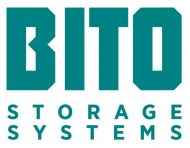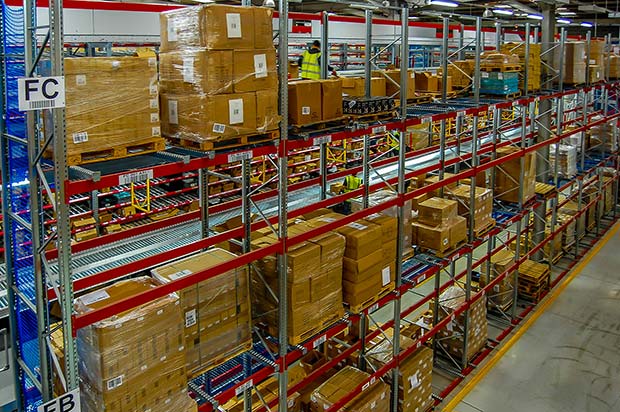BITO Storage Systems is an international provider of storage and order picking systems to a range of industry sectors. In recent times BITO has fitted out small item sortation solutions for manufacturing and distribution operations and equipped packaging zones for retailers as part of etail storage and order picking solutions, including Next and George.com. Duncan Grime, Marketing Manager of BITO Storage Systems Ltd, the UK operation, spoke to Warehouse & Logistics News.

Marketing Manager of BITO Storage Systems Ltd
Warehouse & Logistics News – Duncan, what does your role as Marketing Manager involve?
My responsibilities are to promote awareness of BITO Storage Systems and the service our expert team provides in the logistics community. I am also responsible for our sales channel that supplies products online and through resellers, and oversee product sales, enquiries and service levels from our warehouse.
WLN – Who else is in the senior UK team?
I work alongside an experienced team comprising Neal Rowe, Head of Regional Sales, Matthew Wright, Head of Project Management and Lauren Lenton, Head of Finance. We report to Edward Hutchison, our MD.
WLN – When was BITO founded?
BITO began life in 1845, named after “Bittmann Oberstein,” where the Bittmann family founded the business. BITO Storage Systems UK is one of BITO’s largest subsidiaries and celebrates 20 years here next year.
WLN – How do you service UK customers?
The UK head office is in Nuneaton. We have an experienced team offering a full range of services: solution design, project management, customer support and after-sales service. We also hold extensive stocks for nationwide delivery.
An important aspect is our “Experience Centre,” enabling customers to see how BITO products can help solve their storage and picking requirements. Our sales team consists of a Solutions Design team and Key Account Managers with many years’ experience designing innovative and cost-effective storage and picking solutions. They are supported by an internal team handling product enquiries, customer quotations and orders from our website and resellers.
WLN – As a market for your products and solutions, how does the UK compare with Germany and other countries?
BITO are significantly better known in Germany than here, hence raising our UK profile is so important. BITO operate in most European countries, as well as the USA and UAE. Markets are at different stages of maturity and each has its own characteristics and competitive requirements. The UK, being quite a mature market for logistics, requires solutions that are innovative and improve operational efficiency.
 WLN – How big a part of your business are plastic containers? What different containers are in the current range? Where do you make them?
WLN – How big a part of your business are plastic containers? What different containers are in the current range? Where do you make them?
Containers represent 30% of our turnover and, to facilitate further growth, capacity for the production almost doubled recently at our plant in Lauterecken, near Frankfurt. BITO offer a wide range of plastic bins and containers. Our range starts with small parts storage & picking bins, including the very popular RK bins, progresses in size through industry standard European stacking containers, attached lid distribution containers to large heavy duty containers for use with forklift and pallet trucks. We also offer standard sized containers for use on conveyors and automated bin storage systems. A recent addition is the U-Turn Stack & Nest large capacity container that stacks and nests, saving space when not being used.
WLN – What part of your business is racking and shelving?
Racking and shelving make up about 70% of our UK business. Most products we sell are manufactured in Meisenheim, near Frankfurt, however we also work with UK fabricators to design and produce components for bespoke solutions.
WLN – How large a part of your business is storage and order picking solutions for e-commerce?
Reflecting general market trends, we have also seen significant growth in demand from e-commerce operators. We work closely with customers to understand their objectives and develop a solution that works for them.
WLN – We hear a lot about warehouse automation at the moment. How automated are your solutions?
I would describe our products as low-level automation, products such as carton live and integrated conveyors. BITO recently launched the LEO Locative, an entry-level driverless vehicle to automate simple repetitive tasks.
WLN – What kind of performance improvements can BITO’s storage solutions achieve?
BITO Storage Systems installations transform warehouse operations by giving extra capacity and more efficient picking through greater storage density. As an example, we recently provided Autoparts & Diagnostics in Tewkesbury with a drive through racking design, which doubled their throughput. It accommodates different pallet sizes and allows double stacking, when possible, which reduces the number of lifts by up to 60%.
WLN – Is the UK ready for automation on the scale it’s reached in Germany, for instance? If not, what’s holding us back?
A company’s readiness for automation will depend on their performance and view of the future. Currently, there are two factors influencing this topic, both heavily influenced by the BREXIT process. There is a widely held view that BREXIT will bring about a shortfall in workforce availability for the logistics industry, so logically more automation is a way to minimise that risk. On the other hand, the general uncertainty surrounding BREXIT may in some cases be delaying capital investment decisions.
 WLN – What kinds of savings do driverless transport systems deliver and what kind and scale of operations are they suited to?
WLN – What kinds of savings do driverless transport systems deliver and what kind and scale of operations are they suited to?
BITO’s LEO Locative driverless transport system is suited to any operation. With no Wi-Fi or IT required LEO is easy to set up and run in-house, keeping procurement costs low.
The first UK installation of LEO units is at Siemens Industrial Turbomachinery’s new Global Service Operation Centre, which separates human and busy forklift truck areas by using LEOs to transport goods.
Floor staff productivity is maximised by LEOs taking over simple transporting duties, and reducing travel time by 30%. To match this increased productivity would require two extra full-time operatives on start up and a further three as business ramps up.
The system gives ROI within a year, compared to five years for conventional AGVs. Unlike other AGVs, LEO installation is simple and quick, with the units following tape laid on the floor, giving complete flexibility to reconfigure and maximise efficiency by simply pulling up the tape and relaying new routes. Siemens can scale up by buying or hiring extra LEOs off the shelf.
WLN – As a company do you work on large projects with other suppliers and integrators or do you work solo?
We work with various integrators such as Dematic, Knapp and TGW and with specialist mezzanine floor manufacturers.
WLN – What are the benefits of a one-stop shop solution provider for order picking and storage?
‘The fewer suppliers involved, the more likely the e-tailer, and its customers, will experience smooth fulfilment. As orders move through a warehouse, various items of materials handling equipment come into play: bins, containers and totes will be used to hold items on shelves, racking or flow lanes in live storage. Bins can also be used for internal transport between goods-in, put-away, pick zones and packaging locations. They can travel via person, conveyor, lift truck or automated device.
Sourcing bins from the same manufacturer that provides shelving, racking or live storage will ensure the smoothest operation. Nobody wants, for example, their carton live system to jam because the tote from one manufacturer doesn’t properly fit or refuses to flow smoothly down the flow lane of another. Sourcing from the same supplier ensures bins and racking collaborate. The bins will not only move smoothly but will have also been designed to optimise the space on the shelving or racking.
WLN – You’ve recently fitted out packaging zones for retailers as part of e-tail storage and order picking solutions, including for Next and George.com. What do these solutions involve?
These zones might typically include galvanised shelving, providing pigeon holes to place items in plastic totes for building a customer order. These shelves can surround packing tables equipped with waste bins, pull-out drawers, a computer shelf and a monitor stand – everything needed to pack efficiently.
WLN – In your view, can packaging zones be automated, or will packing remain a manual process in e commerce operations for the foreseeable future?
Like any form of automation, once volumes provide a justifiable return on investment, then that decision can be taken. However the complexity of the packaging operation needs to be factored in. An order can often involve a variety of SKUs of different shapes and sizes that need to be packed optimally to ensure sufficient protection with the minimal weight. Presentation, especially in retail e-commerce, is often a key requirement to uphold a company’s image and reputation for service. Given that packers are the last people to touch a product before it goes to the customer, they work at the sharp end of increasingly shorter order lead times and busier peak throughputs, such as Christmas and Black Friday. This is where experience particularly counts to get the packaging just right despite large volumes and the pressure of time constraints.
WLN – Are you exhibiting at any exhibitions this year or next?
In 2019 we plan to be at Intralogistex and IMHX.
WLN – Where do you see BITO in five years’ time?
Once the BREXIT uncertainty is behind us, we see the logistics sector continuing to develop, with BITO experiencing further growth through an increased market presence and the development of new products.




Comments are closed.